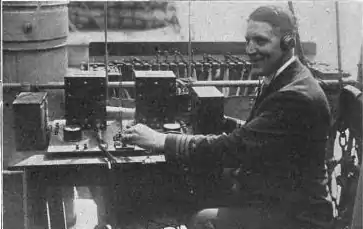Frequency range | 0.3 to 3 kHz |
|---|---|
Wavelength range | 1,000 to 100 km |
| Radio bands | ||||||||||||
|---|---|---|---|---|---|---|---|---|---|---|---|---|
| ITU | ||||||||||||
|
||||||||||||
| EU / NATO / US ECM | ||||||||||||
| IEEE | ||||||||||||
| Other TV and radio | ||||||||||||

Ultra low frequency (ULF) is the ITU designation[1] for the frequency range of electromagnetic waves between 300 hertz and 3 kilohertz, corresponding to wavelengths between 1,000 to 100 km. In magnetosphere science and seismology, alternative definitions are usually given, including ranges from 1 mHz to 100 Hz,[2] 1 mHz to 1 Hz,[3] and 10 mHz to 10 Hz.[4]
Many types of waves in the ULF frequency band can be observed in the magnetosphere and on the ground. These waves represent important physical processes in the near-Earth plasma environment. The speed of the ULF waves is often associated with the Alfvén velocity that depends on the ambient magnetic field and plasma mass density.
This band is used for communications in mines, as it can penetrate the earth.[5]
Earthquakes
Some monitoring stations have reported that earthquakes are sometimes preceded by a spike in ULF activity. A remarkable example of this occurred before the 1989 Loma Prieta earthquake in California,[6] although a subsequent study indicates that this was little more than a sensor malfunction.[7] On December 9, 2010, geoscientists announced that the DEMETER satellite observed a dramatic increase in ULF radio waves over Haiti in the month before the magnitude 7.0 Mw 2010 earthquake.[8] Researchers are attempting to learn more about this correlation to find out whether this method can be used as part of an early warning system for earthquakes.
Earth mode communications
ULF has been used by the military for secure communications through the ground. NATO AGARD publications from the 1960s detailed many such systems, although it is possible that the published papers left a lot unsaid about what actually was developed secretly for defense purposes. Communications through the ground using conduction fields is known as "Earth-Mode" communications and was first used in World War I. Radio amateurs and electronics hobbyists have used this mode for limited range communications using audio power amplifiers connected to widely spaced electrode pairs hammered into the soil. At the receiving end, the signal is detected as a weak electric current between a further pair of electrodes. Using weak signal reception methods with PC-based DSP filtering with extremely narrow bandwidths, it is possible to receive signals at a range of a few kilometers with a transmitting power of 10–100 W and electrode spacing of around 10–50 m.
See also
References
- ↑ "Rec. ITU-R V.431-7, Nomenclature of the frequency and wavelength bands used in telecommunications" (PDF). ITU. Archived from the original (PDF) on 31 October 2013. Retrieved 20 February 2013.
- ↑ V. A. Pilipenko, "ULF waves on the ground and in space", Journal of Atmospheric and Terrestrial Physics, Volume 52, Issue 12, December 1990, pp. 1193–1209, ISSN 0021-9169, doi:10.1016/0021-9169(90)90087-4.
- ↑ T. Bösinger and S. L. Shalimov, "On ULF Signatures of Lightning Discharges", Space Science Reviews, Volume 137, Issue 1, pp. 521–532, June 2008, doi:10.1007/s11214-008-9333-4.
- ↑ O. Molchanov, A. Schekotov, E. Fedorov, G. Belyaev, and E. Gordeev, "Preseismic ULF electromagnetic effect from observation at Kamchatka", Natural Hazards and Earth System Sciences, Volume 3, pp. 203–209, 2003
- ↑ HF and Lower Frequency Radiation - Introduction Archived 2005-11-09 at the Wayback Machine
- ↑ Fraser-Smith, Antony C.; Bernardi, A.; McGill, P. R.; Ladd, M. E.; Helliwell, R. A.; Villard, Jr., O. G. (August 1990). "Low-Frequency Magnetic Field Measurements Near the Epicenter of the Ms 7.1 Loma Prieta Earthquake" (PDF). Geophysical Research Letters. 17 (9): 1465–1468. Bibcode:1990GeoRL..17.1465F. doi:10.1029/GL017i009p01465. ISSN 0094-8276. OCLC 1795290. Retrieved December 18, 2010.
- ↑ Thomas, J. N.; Love, J. J.; Johnston, M. J. S. (April 2009). "On the reported magnetic precursor of the 1989 Loma Prieta earthquake". Physics of the Earth and Planetary Interiors. 173 (3–4): 207–215. Bibcode:2009PEPI..173..207T. doi:10.1016/j.pepi.2008.11.014.
- ↑ KentuckyFC (December 9, 2010). "Spacecraft Saw ULF Radio Emissions over Haiti before January Quake". Cambridge, Massachusetts: MIT Technology Review. Retrieved December 18, 2010.
External articles
- Tomislav Stimac, "Definition of frequency bands (VLF, ELF... etc.)". IK1QFK Home Page (vlf.it).
- NASA live streaming ELF -> VLF Receiver
- Amateur Radio Below 10 kHz "G3XBM's page on Earth Mode Communication"
- Review of Earth Mode Communications "1966 abstract about Earth Mode Comms by Ames, Frazier and Orange"
- Radio communications within the Earth's crust "Abstract of article by Burrows written in 1963"
